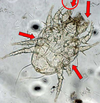Fleas, ticks, mites and Lice recognition Flashcards
What is this? and what problems does it cause? and what is most common one?

Flea (siphonaptera) - small, dark brown, wingless insect, laterlly compressed with long hind limbs and dark combs on head for ID
blood sucking
FAD
intermediate host for diphylidium
vector for bubonic plague, parvo and myxomatosis
Ctenocephalidis felis
What LC is this? What happens to the dirt?

Flea LC
Flea dirt made by adults (faeces) eaten by flea larvae
almost permenant parasite
larvae moulting is temperature dependent
LC is 3-4 weeks in summer
only 5% of population on host
What is this?

Blood sucking (narrow head, large legs) louse(phthiraptera) - piercing mouthparts, feed on blood and tissue fluid, mammals only
can cause pediculosis - anaemia, self injury, hair loss
intermediate for diphylidium
dorsoventrally flattenned
3 pairs of legs with claws
wingless
What is this?

Chewing lice
broad head
small narrow legs
rasping mouthparts, feed on ep scales, scabs, feathers etc
mammals and birds
Who does this LC belong to?

Lice
on host
2-3 weeks
transmission by close contact
only survive off host for short periods
adult lice and nits attach themselves to hair
What is this, what sex ?

Male adult hard tick
complete scutum, festoons, ornate (can be plain). prominant mouth parts
tick worry, blood loss, disease transmission, production loss, secondary inf at bite site
what is this and what sex?

Female hard tick
incomplete scutum
rest of body wall is convoluted to allow large blood meal
What is this?

Soft tick
no scutum, mouthparts not visible from dorsal surface, dont swell much as feed little and often
What do these mouthparts belong to and what do the arrows point to?

Tick mouthparts
Green = hypostome (tube for sucking host blood, has backward pointing teeth)
Red = palps (sensory organs)
Chelicerae puncture skin
mouthparts are cemented into skin and tick stands upright whilst feeding
feeds continuously and injects saliva
Who does this LC belong to?

Ticks :)
larva have 3 pairs of legs and nymph have 4
hard tick LC can be classified into 1/2/3 host
soft ticks feed little and often on many hosts
What sp is this?

Ixodes Ricinus
hard, 3 host tick
vector for: lyme disease, bovine babesiosis, louping ill, tickborne fever, tick pyaemia,
spend most of time on ground in vegetation
activity in spring and autumn
What species is this?

Amblyomma - hard, 3 host
overseas
vector for Q fever, rocky mountain spotted fever
What species is this?

Boophilus hard tick, 1 host
warmer climates
vector for babesia in cattle
What species is this?

Dermacentor tick - hard, 3 host
vector for: tickborne encephalitis, equine babesiosis
What species is this?

Rhipicephalus tick - hard, 2/3host
babesia vector
paralysis in livestock
warmer climates
What species is this?

Ornithodors sp - soft tick (sand tampans)
vector for relapsing fever and african swine fever
warmer climates
What species is this?

Otobius sp - soft tick
america, india, SA
ears of cattle and dogs
predispose to myiasis
What is this?

Sarcoptes mites - burrowing
small and round, short legs, dorsal pegs and spines, terminal anus
erythema with papule formation
scale, crust, alopecia, intense puritis, self traums, wrinkling of skin
mange
notifiable in sheep
zoonotic
diagnose by deep skin scrape
Who does this LC belong to?

Sarcoptes mites - burrowing
larvae have 3 pairs of legs and nymphs have 4
What is this and what caused it?

Scaly leg in chicken
Knemidocoptes mutans - burrowing mite
burrow under scales - ragged appearance -distorted feet/legs - lame
recognise by u shaped chitinous bar behind head
What is this and what caused it?

Scaly beak in birds
Knemidocoptes pilae
mites- beak, face, body - burrow - spread across face
little pruritis
What is this?

Demodex burrowing mite
normally a commensal on all domestic mammals and birds
cigar shaped with 4 pairs of stumpy legs
found in hair follicles and sebaceous glands
can be squamous/pustular demodecosis
lots of larvae and nymph from deep skin scraping indicates an active infection
What is this?

psorptes - non burrowing mite (surface)
active in keratin layer of skin with piercing mouth
oval, long legs, funnel shaped suckers on segmented pedicels
egg - larvae - nymph - adult (10 days)
sheep scab, winter disease, self inflicted trauma
mainly spread by direct contact
can get hypersensitivity reaction
report cases to DEFRA
Which species of mite(non burrowing) do these legs belong to?

Left = psorptes
(funnel shaped sucker on segmented pedicel)
Right = Choiroptes
(cup shaped suckers on un segmented pedicel)
found on horses and ruminants, less pathogenic, mouthparts dont pierce skin,
What is this and what caused it?

Otodectic mange in dog ear (mites induce formation of brown waxy exudate - crusty - secondary bacterial inf - purulent otitis )
in external ear - under crust
long legs as surface mite
in most cats
common cuase of otitis externa in dogs - frequent head shaking, ear scratching, waxy masses in ears
What species of surface mite is this?

Cheylitiella
mild skin disease - excess scurf (dandruff)
long legs and waisted body, claw like palps at head end, combs at end of each leg
live in hair/fur and only visit skin to feed
very contagious
What species of non burrowing mite is this?

Dermanyssus/ red mite of poulty (D. gallinae)
spider like, white - red when engorged with blood, few hairs on body, hooks on legs
spends most of time off host
survives months without feeding
What species of non burrowing mite is this?

Neotrombicula - surface mite
3 pairs of legs, hairy , bright orange
N.autumnalis = harvest mite
any animal
larvae is parasitic - adult and nymph free living on ground
intense irritation and self trauma
eggs in soil - larvae clib vegetation to find host
greatest in late summer


